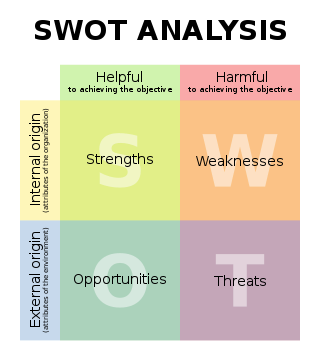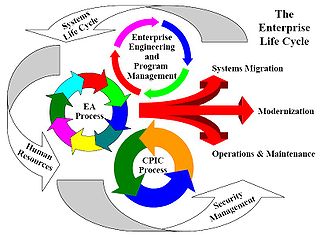Related Research Articles
Software development is the process of conceiving, specifying, designing, programming, documenting, testing, and bug fixing involved in creating and maintaining applications, frameworks, or other software components. Software development involves writing and maintaining the source code, but in a broader sense, it includes all processes from the conception of the desired software through to the final manifestation of the software, typically in a planned and structured process. Software development also includes research, new development, prototyping, modification, reuse, re-engineering, maintenance, or any other activities that result in software products.

SWOT analysis is a strategic planning and strategic management technique used to help a person or organization identify Strengths, Weaknesses, Opportunities, and Threats related to business competition or project planning. It is sometimes called situational assessment or situational analysis. Additional acronyms using the same components include TOWS and WOTS-UP.

IDEF, initially an abbreviation of ICAM Definition and renamed in 1999 as Integration Definition, is a family of modeling languages in the field of systems and software engineering. They cover a wide range of uses from functional modeling to data, simulation, object-oriented analysis and design, and knowledge acquisition. These definition languages were developed under funding from U.S. Air Force and, although still most commonly used by them and other military and United States Department of Defense (DoD) agencies, are in the public domain.

In systems engineering, information systems and software engineering, the systems development life cycle (SDLC), also referred to as the application development life cycle, is a process for planning, creating, testing, and deploying an information system. The SDLC concept applies to a range of hardware and software configurations, as a system can be composed of hardware only, software only, or a combination of both. There are usually six stages in this cycle: requirement analysis, design, development and testing, implementation, documentation, and evaluation.

A business analyst (BA) is a person who processes, interprets and documents business processes, products, services and software through analysis of data. The role of a business analyst is to ensure business efficiency increases through their knowledge of both IT and business function.

The Open Group Architecture Framework (TOGAF) is the most used framework for enterprise architecture as of 2020 that provides an approach for designing, planning, implementing, and governing an enterprise information technology architecture. TOGAF is a high-level approach to design. It is typically modeled at four levels: Business, Application, Data, and Technology. It relies heavily on modularization, standardization, and already existing, proven technologies and products.
Technology strategy is the overall plan which consists of objectives, principles and tactics relating to use of technologies within a particular organization. Such strategies primarily focus on the technologies themselves and in some cases the people who directly manage those technologies. The strategy can be implied from the organization's behaviors towards technology decisions, and may be written down in a document. The strategy includes the formal vision that guide the acquisition, allocation, and management of IT resources so it can help fulfill the organizational objectives.
Data architecture consist of models, policies, rules, and standards that govern which data is collected and how it is stored, arranged, integrated, and put to use in data systems and in organizations. Data is usually one of several architecture domains that form the pillars of an enterprise architecture or solution architecture.

An enterprise architecture framework defines how to create and use an enterprise architecture. An architecture framework provides principles and practices for creating and using the architecture description of a system. It structures architects' thinking by dividing the architecture description into domains, layers, or views, and offers models - typically matrices and diagrams - for documenting each view. This allows for making systemic design decisions on all the components of the system and making long-term decisions around new design requirements, sustainability, and support.

Enterprise modelling is the abstract representation, description and definition of the structure, processes, information and resources of an identifiable business, government body, or other large organization.
Service-oriented modeling is the discipline of modeling business and software systems, for the purpose of designing and specifying service-oriented business systems within a variety of architectural styles and paradigms, such as application architecture, service-oriented architecture, microservices, and cloud computing.
Facility condition assessment is an analysis of the condition of a facility in terms of age, design, construction methods, and materials. The individuals who perform the assessment are typically architects and engineers, and skilled-trade technicians. Engineering and architectural professional opinions as to the conditions observed are part of the assessment. Building diagnostics go beyond facility condition assessments to determine solutions to the problems found and predict outcomes of the solutions.
Gerardus Maria "Sjir" Nijssen is a Dutch computer scientist, former professor of computer science at the University of Queensland, consultant, and author. Nijssen is considered the founder of verbalization in computer science, and one of the founders of business modeling and information analysis based on natural language.

Enterprise life cycle (ELC) in enterprise architecture is the dynamic, iterative process of changing the enterprise over time by incorporating new business processes, new technology, and new capabilities, as well as maintenance, disposition and disposal of existing elements of the enterprise.
Steven Howard Spewak was an American management consultant, author, and lecturer on enterprise architectures, known for the development of Enterprise Architecture Planning (EAP).
In software engineering, a software development process is a process of dividing software development work into smaller, parallel, or sequential steps or sub-processes to improve design and/or product management. It is also known as a software development life cycle (SDLC). The methodology may include the pre-definition of specific deliverables and artifacts that are created and completed by a project team to develop or maintain an application.
Macroscope is an integrated set of methods aimed at enterprise IT activities. Macroscope was developed and is maintained by Fujitsu in Canada. It is primarily used as their core body of knowledge to support the consulting services that they provide to their clients and is also licensed as a commercial product to a number of their clients
Enterprise data planning is the starting point for enterprise wide change. It states the destination and describes how you will get there. It defines benefits, costs and potential risks. It provides measures to be used along the way to judge progress and adjust the journey according to changing circumstances.
The history of business architecture has its origins in the 1980s. In the next decades business architecture has developed into a discipline of "cross-organizational design of the business as a whole" closely related to enterprise architecture. The concept of business architecture has been proposed as a blueprint of the enterprise, as a business strategy, and also as the representation of a business design.
The Integrated Management Concept, or IMC is an approach to structure management challenges by applying a "system-theoretical perspective that sees organisations as complex systems consisting of sub-systems, interrelations, and functions". The most characteristic aspect of the IMC is its distinction between three particular management dimensions: normative, strategic, and operational management, which are held together by different integration mechanisms. The normative management dimension determines the general aim of the organization, the strategic dimension directs the plans, basic structures, systems, and the problem-solving behaviour of the staff for achieving it, and the operative level translates the normative missions and strategic programs into day-to-day organizational processes.
References
- 1 2 3 Ed Tozer at amazon.com. Accessed 9 May 2015.
- ↑ Andriole, Stephen J. "The collaborate/integrate business technology strategy." Communications of the ACM 49.5 (2006): 85-90.
- ↑ Peña-Mora, Feniosky; Tanaka, Shunsuke (2002). "Information technology planning framework for Japanese general contractors" (PDF). Journal of Management in Engineering. 18 (3): 138–149. doi:10.1061/(asce)0742-597x(2002)18:3(138). hdl: 1721.1/9012 .
- 1 2 Tozer (1986); Tozer, Edwin E. (1986). "Developing strategies for management information systems". Long Range Planning. 19 (4): 31–40. doi:10.1016/0024-6301(86)90267-0.
- ↑ "Edwin E. Tozer Limited," at duedil.com. Accessed 23-03-2015.
- ↑ E. E. Tozer at DBLP Bibliography Server
- ↑ Tozer (1975)
- 1 2 Tozer (1976)
- ↑ Tozer (1986)
- 1 2 Farsheed Azad. "MSc. Information Engineering: An investigation on models and methodologies for developing an I.S. Strategy," June 1990. at pchelpline.com, uploaded 2012/07. Accessed 23-03-2015
- ↑ James Martin. Viewdata and the information society. 1982
- 1 2 Tozer (1998)